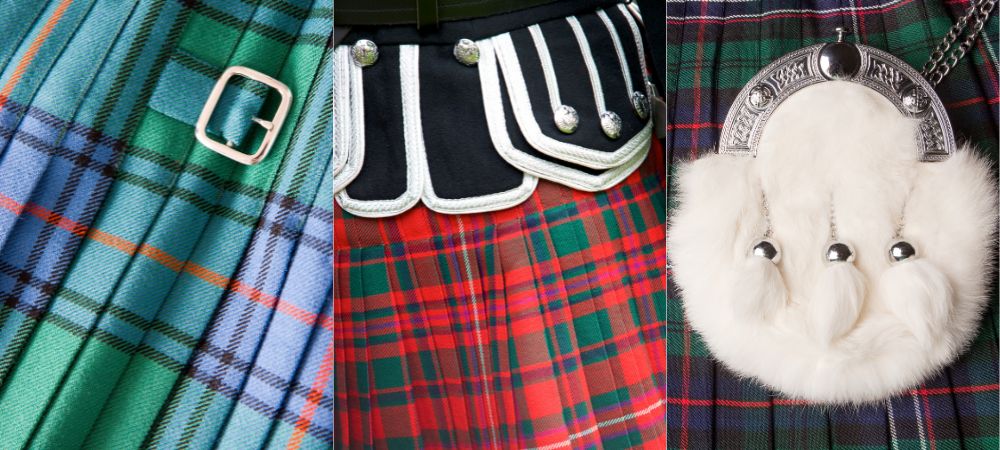A kilt, an iconic symbol of Scottish heritage, embodies a rich tapestry of history and pride. With its deep-rooted cultural significance, this distinctive garment is not just a piece of clothing but a legacy representation. As such, it requires meticulous care and attention to preserve its beauty and integrity.
This guide aims to empower you with essential knowledge and practical tips on the best way to care for kilt. By understanding the nuances of kilt care, from fabric-specific considerations to proper cleaning techniques, you can ensure that your cherished garment remains in pristine condition for years to come, proudly showcasing your connection to a storied tradition.
Understanding Your Kilt's Fabric

Grasping the nature of your kilt's fabric is pivotal in its upkeep. Kilts come in varied materials such as wool, polyviscose, and their blends, each demanding distinct care methods. Wool, renowned for its warmth and classic texture, is particularly sensitive. It's prone to shrinking and felting if mishandled.
Polyviscose, a blend of synthetic fibers, offers more resilience and is less susceptible to damage from moisture or pests. However, it still requires thoughtful care to maintain its appearance. Recognizing these differences is the first step in effective kilt maintenance. By catering to the unique needs of your kilt's fabric, you can significantly prolong its life and keep it looking as regal as ever. You need to pay attention to your kilt care!
Regular Maintenance: Keeping Your Kilt in Top Condition
Consistent and mindful upkeep is crucial for preserving your kilt's elegance. Regular maintenance includes gentle cleaning and careful handling to avoid unnecessary wear. When donning your kilt, be vigilant about potential stain-inducing situations.
Spills should be addressed promptly to prevent permanent marks. Also, watch out for rough surfaces which might snag or tear the fabric. Daily maintenance can be as simple as brushing the kilt with a soft-bristled brush to remove dust and lint. Whether its traditional women's kilt or men’s, this routine helps in keeping the fabric fresh and less prone to long-term damage.
Remember, the key to a well-maintained kilt lies in these small, regular acts of care.
Cleaning Your Kilt: Do It Right
Proper cleaning techniques are fundamental in kilt care, particularly for woolen kilts. Machine washing, a common convenience for many garments, is a strict no for kilts. The agitation and varying temperatures in a washing machine can be detrimental to the fabric, leading to shrinking, warping, or fading.
For spot cleaning, use a gentle detergent and cold water, dabbing the stain rather than rubbing it. This method prevents the stain from settling deeper into the fabric. For comprehensive cleaning, seeking a professional dry cleaner experienced in handling kilts is advisable. They will have the expertise and the right solvents to clean your kilt thoroughly without harming its fabric or design. Keep your casual and wedding kilts with care.
Remember, the longevity of your kilt significantly depends on how well it is cleaned and cared for.
Ironing Your Kilt: A Delicate Process
Ironing a kilt is an art that requires meticulous attention. Using a low heat setting on your iron is essential to avoid damaging the fabric, especially if it's wool, which is susceptible to scorching. Placing a protective cloth between the iron and the kilt can further safeguard against heat damage.
Focus your ironing efforts on the apron - the flat front panel of the kilt. The pleats, a defining feature of the kilt, should typically be left untouched as ironing them can flatten their distinctive crispness. Instead, simply hang the kilt up after wearing it to allow any wrinkles in the pleats to fall out naturally. This careful approach ensures that your kilt, either a sports kilt or an occasional one, retains its traditional shape and design.
Storing Your Kilt: Tips for Longevity
Proper storage is crucial in preserving the integrity and appearance of your kilt. It's advisable to avoid folding your kilt for storage, as this can lead to deep-set creases that are difficult to remove. A kilt hanger is an ideal investment, as it allows the kilt to hang naturally, maintaining its shape.
Store the kilt in a cool, dry environment to prevent any moisture-related damage, such as mold or mildew. If you need to fold your kilt for travel, do it as loosely as possible, and make sure to unpack and hang it up as soon as you can. This careful approach to storage plays a significant role in extending the life and beauty of your kilt.
Protecting Your Kilt from Moths and Pests
Moths pose a serious threat to wool kilts, as they can cause irreparable damage. To protect your kilt, use natural moth repellents like cedar blocks or lavender sachets. These keep moths away and impart a pleasant aroma to your kilt.
Regularly inspect your kilt for any signs of pest damage. If you detect moths, act quickly to clean your kilt and the storage area to eliminate the infestation. It's also a good practice to occasionally air out your kilt in sunlight, which can deter pests. These proactive measures are essential in ensuring your kilt remains free from damage caused by moths and other pests.
Dealing with Wrinkles and Creases
Wrinkles and creases are inevitable, but they can be managed with proper care. Hanging your kilt in a steamy bathroom is a gentle way to ease out wrinkles. The steam helps relax the fabric, smoothing out creases without direct contact. This method is particularly useful for kilts made of delicate fabrics like wool.
For more stubborn creases, refer to the ironing tips provided earlier, always remembering to use a protective cloth and a low heat setting. Regularly airing out and hanging your kilt correctly can prevent many wrinkles from forming in the first place, saving you time and effort in maintenance.
FAQs:
How often should I clean my kilt?
The frequency of cleaning depends on how often you wear your kilt and the conditions it's exposed to. For regular wear, a thorough cleaning once or twice a year is sufficient. However, if your kilt gets stained or is worn in dusty or dirty environments, it may require more frequent cleaning.
Can I machine wash my kilt?
It's strongly advised not to machine wash your kilt, especially if it's made of wool. Machine washing can cause shrinking, felting, or damage to the fabric. Instead, opt for spot cleaning or professional dry cleaning for thorough cleaning.
How do I store my kilt when not in use?
Store your kilt on a kilt hanger in a cool, dry place. Avoid folding it to prevent creases. If you must fold it for travel, do so loosely and hang it up as soon as possible. Protect it from moths and pests using natural repellents like cedar or lavender.
What is the best way to iron a kilt?
When ironing, use a low heat setting and place a cloth between the iron and the kilt. Focus on ironing the apron and avoid ironing the pleats. Let the pleats hang naturally to maintain their shape.
How can I remove wrinkles from my kilt without ironing?
Hanging your kilt in a steamy bathroom can help remove wrinkles without direct heat. The steam relaxes the fabric, easing out the creases. For stubborn wrinkles, refer back to the careful ironing method.
What should I do if my kilt gets wet?
If your kilt gets wet, hang it up to dry naturally, away from direct heat or sunlight. Do not tumble dry, as this can cause shrinkage or damage. Once dry, gently brush it to restore its texture.
How can I protect my kilt from moths?
Use natural moth repellents like cedar blocks or lavender sachets in your storage area. Regularly inspect your kilt for any signs of moth damage and clean your storage area to prevent infestations.
Can I mend my kilt if it gets torn or damaged?
Yes, kilts can be mended, but it's best done by a professional experienced in kilt repairs to ensure the repair is as unnoticeable as possible and maintains the kilt's integrity.
Conclusion:
Your kilt transcends mere fashion; it is a revered symbol of heritage and a testament to enduring pride. Adhering to these essential maintenance and storage guidelines ensures that your kilt remains more than just an exquisite piece of clothing; it becomes a treasured heirloom rich in history and craftsmanship.
The care you invest in your kilt maintains its aesthetic allure and honors the deep-rooted traditions it embodies. Every thread weaves a story of cultural significance, and your dedication to its upkeep allows these tales to continue for generations.
To experience the unique elegance and the profound cultural heritage that a kilt offers, explore the exceptional collection at Super Kilts. Embrace the legacy and the craftsmanship of a timeless garment ready to accompany you on all your special occasions. Visit Super Kilts today and find the perfect kilt that resonates with your style and heritage.














